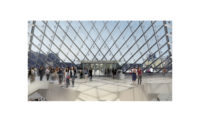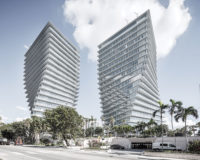Los Angeles
In 2004, before the real estate crash, the city of Los Angeles and developer Related Companies had plans for downtown's Grand Avenue that were, well, grand. The Grand Avenue Development Project was originally slated to include a $2 billion Frank Gehry—designed hotel, condos, and a retail complex. While the long-delayed project has been drastically scaled back since its approval in 2007, the first phase of the development, the 12-acre Grand Park, opened last summer.
For a city lacking in great parks, Grand Park represents a turning point. Paid for by Related and designed by local architecture firm Rios Clementi Hale Studios (RCHS), the $56 million project creates a pedestrian-friendly space between Grand Avenue's Music Complex and City Hall, four blocks away.
The park sits on the former site of an inhospitable and forgotten civic plaza and surface parking lot that stretched from Grand Avenue to Spring Street. “It was cut off from the urban fabric,” says Rios Clementi Hale Studios senior associate Tony Paradowski. The park replaces the plaza with terraced lawns and gardens that descend along a 90-foot grade change from east to west. Divided by two city streets, it is organized along four public spaces, or blocks. These spaces include a restored fountain plaza, a performance lawn, a community terrace ringed by gardens, and an event lawn that can host public gatherings or marketplaces.
The architects were challenged to create a destination that would appeal to an ethnically and economically diverse community. The park also needed to complement its neighboring cultural landmarks, both visually and in terms of programming, including Gehry's Walt Disney Concert Hall, Arata Isozaki's Museum of Contemporary Art, Rafael Moneo's Cathedral of Our Lady of the Angels, and the Broad Museum designed by Diller Scofidio + Renfro (expected to be complete in fall 2014). To ensure community input, the architects hosted interactive workshops and forums with multiple stakeholders, including neighborhood residents, arts associations, and civic organizations.
RCHS designed the park to support a variety of activities, from community events to cultural festivals and Music Center programming (Music Center venues include the Dorothy Chandler Pavilion and the Disney hall, among others). To encourage flexible uses, the firm eschewed building a traditional band shell in favor of multi-use lawns and plazas. “It's not overly designed,” says Paradowski. “Los Angeles has an informality that other cities don't have.”
Visitors can enter the park from either end, but the Grand Avenue entrance stairs offer a sweeping view of the fountain and City Hall. L.A.'s freewheeling unpretentiousness is evident in the bright magenta metal lawn furniture dotting the landscape. This movable custom furniture (manufactured by Janus et Cie) allows visitors to group tables and chairs as they wish. “We looked at the iconography of parks in other cities that are really memorable,” explains Paradowski. “Furnishings make the park. We wanted something that was adaptable for everybody.”
A splash pad connects to the historic Arthur J. Will Memorial Fountain, creating an interactive water feature for children to play in. “I call it our urban beach,” says L.A. writer Jessica Ritz, who typically opts to bring her two sons to the park instead of braving the drive across the traffic-choked city to the ocean. The landscape includes new lawns and gardens, a dog run, and a 2/3-mile pedestrian loop. There are also new public restrooms, a Starbucks, and park offices housed within two modern glass buildings with asymmetrical canopies.
One of the architects' biggest challenges was the site's steep topography. To make the park as accessible as possible, the firm built crisscrossing paths and sloping terraces to provide a more seamless experience as visitors move from one level to another. Curving meridian paths conceptually and visually extend into and connect the park to other downtown neighborhoods, including the Historic Core to the south and Chinatown to the north. “The overall layout is an abstracted map of longitude and latitude lines,” says Paradowski. The gardens feature colorful drought-tolerant vegetation from all over the world. An environmental graphics program designed by Sussman/Prejza includes giant markers that label and describe each species.
With other public amenities, such as a new pedestrian plaza in Silver Lake (also designed by RCHS), parklets replacing parking spaces in downtown and northeast L.A., improved bike lanes, and an expanding Metro system, the city is undergoing a prodigious change in its embedded car culture. Grand Park, like these other phenomena, represents a shift in L.A.'s self-perception, especially as neighborhoods, like downtown, become denser and more residential—50,000 people live downtown, up from fewer than 20,000 in the late 1990s. “There's never been a critical mass in that vicinity before,” notes Paradowski.“ More and more, you'll see a response to that.”
Size:12 acres
Cost: $56 Million
Completion date: July 2012
PeopleOwner: County of Los Angeles; Operator: The Music Center; Client: The Grand Avenue Committee, Related Companies, County of Los Angeles
Architect:
Personnel in architect's firm who should receive special credit:
Engineer(s): Structural Engineer: Nabih Youssef & Associates MEP Engineer: Levine/Seegel Associates
Consultant(s): Lighting: Lighting Design Alliance
Other: General contractor: Pankow Builders
Photographer(s):
Jim Simmons |
Products
Furnishings: Reclaimed wood decking for custom communal table(Bengkirai Reclaimed Decking Mix): Terra Mai
Lighting
Conveyance
Add any additional building components or special equipment that made a significant contribution to this project: |











Post a comment to this article
Report Abusive Comment